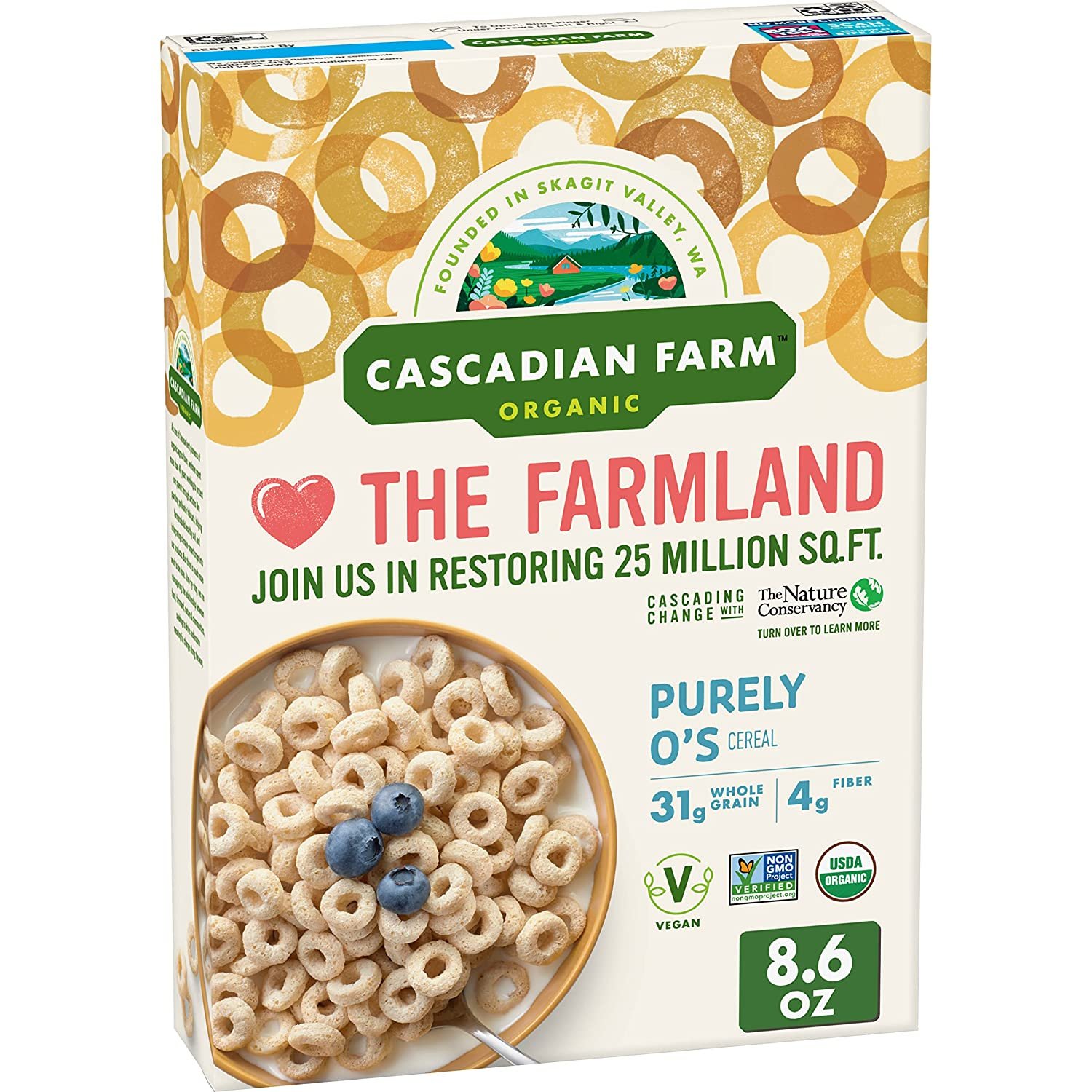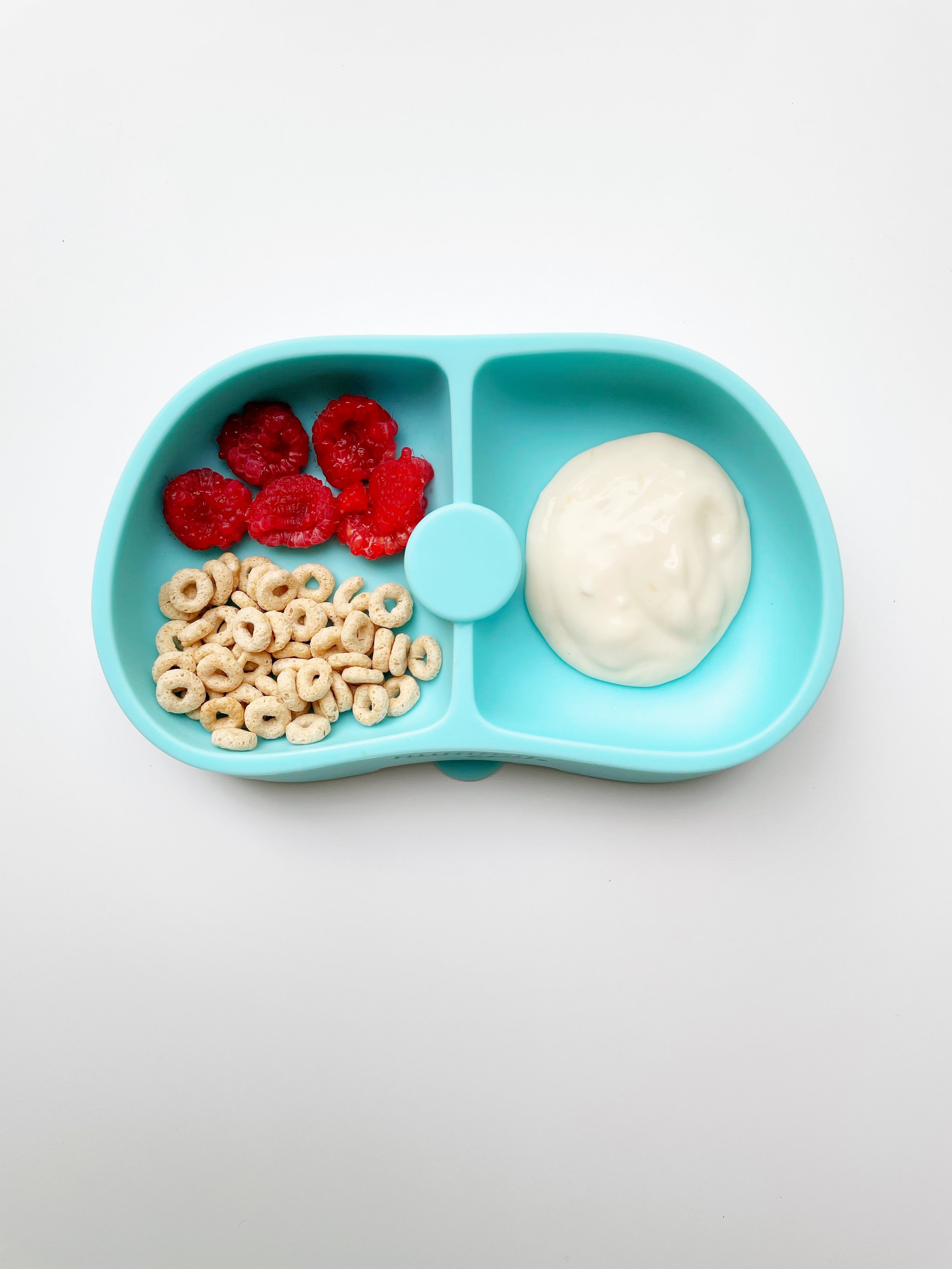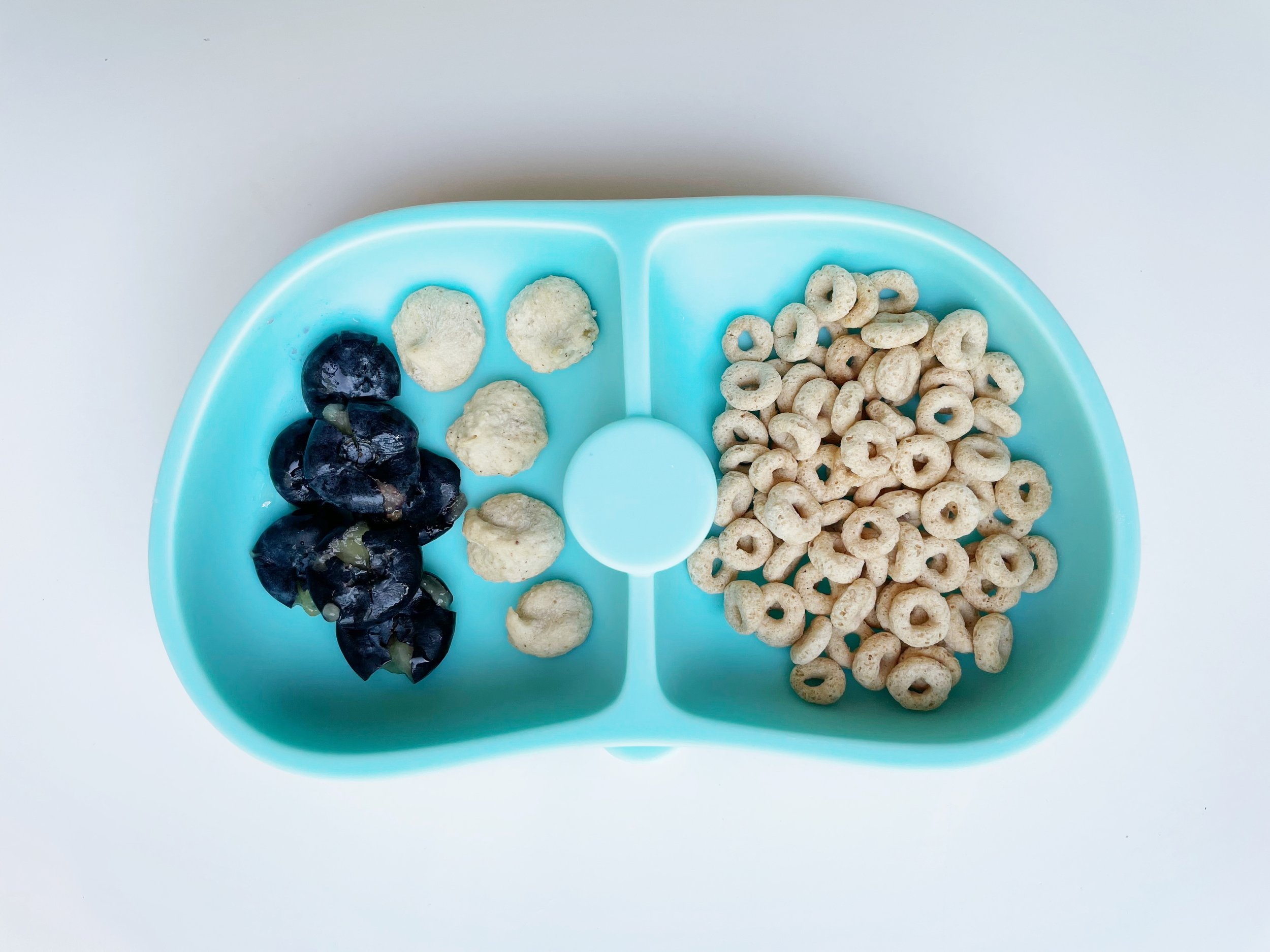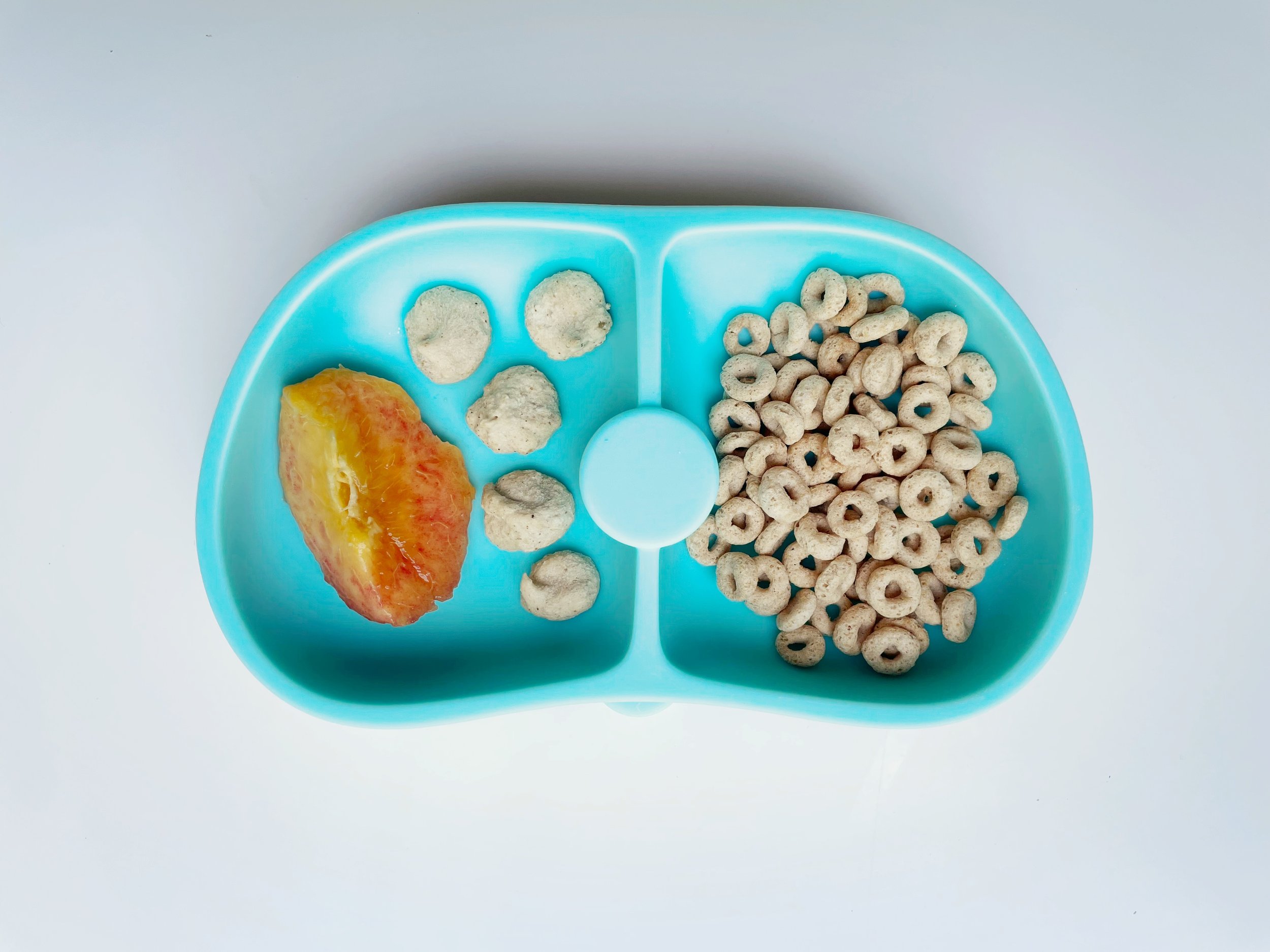When Can Babies Have Cheerios?
This blog contains affiliate links, meaning that if you choose to purchase a product through a link, I will receive a small commission - this in no way impacts the amount you pay. Affiliate links are marked with an asterisk (*).
Complementary feeding starts at around 6 months old. So, you might be wondering when babies can have Cheerios?
Cheerios make their way into many households with young kids.
If I had a dime for the number of times, o-shaped oat cereals like Cheerios saved my girls and me from meltdowns when they were babies...things might be looking pretty different!
Cheerios are small enough for babies to eat without any prep work from parents.
Many are low in sugar.
They’re a portable and easy snack to take when out and about.
What’s not to love?
Well, not all "o" cereals have the same nutritional value, and some are loaded with added sugar.
There are a few things to consider before offering o-shaped cereals to your babe. Let's take a look at when to introduce Cheerios, which one of the many Cheerios flavors are best for babies, and which brands are good alternatives.
Plain Cheerios served in the context of some balanced baby meals (pictured here are smashed berries, ripe peach wedge, plain yogurt, and Mascarpone Peanut Butter Melts.)
What Age Can Babies Eat Cheerios?
Introducing solid foods should happen at around 6 months of age, when the signs of readiness are present. According to the AAP, you don't have to introduce foods in a specific order for most kiddos.
There are a few tips to keep in mind…
First, early foods should be soft in texture or pureed to reduce the risk of choking.
Cheerios are common food that is small and virtually safe for most babies. But before introducing your baby to Cheerios, watch for signs that your child is ready to eat solids.
These signs include being able to sit upright with minimal support, having good head and neck control, and showing interest in food, as well as being able to grab larger objects and bring them up to the mouth.
By ~6 months old, babies can palm larger foods up to the mouth, gum soft foods, and eat from a preloaded spoon.
By about 9 months old, the pincer grasp usually emerges, and babies can pick up small pieces of food between the thumb and index finger and self-feed.
Children develop at their own pace, so there's no exact age when every baby is ready to eat Cheerios.
My recommendation as a pediatric registered dietitian is to wait to feed your baby hard, o-shaped, meltable foods like Cheerios until the baby can pick up small bits of food using a pincer grasp and "chew."
What do I mean?
Baby has Developed a Pincer Grasp
Bite-sized pieces of foods like "o" breakfast cereals require at least an emerging pincer grasp for self-feeding, or else you may find yourself with a frustrated baby who can’t grasp the food, or a baby who palms larger handfuls of cereal into the mouth. The pincer grasp is a fine motor skill that usually shows up at ~9 months.
Able to “Chew”
Cheerios aren't necessarily a common choking hazard, but…
Babies should be able to "chew" with their gums. First, allow your baby to get some practice with very soft foods before offering harder textures like o-shaped cereals. Oat cereals like Cheerios do eventually “melt” in the mouth when they come in contact with saliva, but not right away. If a baby hasn’t yet had much experience with chewing, they may try to swallow a Cheerio without mashing it down first.
One way to help babies get used to the texture of Cheerios is to soak them in a little liquid the first few times you offer it.
What’s the Best Option–Cheerios or Puffs for Babies?
Puffs melt right away in a baby's mouth and are a good transition food from soft textures to "o" cereals. The round shape is manageable for babies starting to develop their pincer grasp. And this snack dissolves in saliva quickly, so the choking risk is very low. Babies get some practice, feeling a bit of food in their mouth and use the chewing motion as it dissolves.
There are many brands to choose from. Most are made with mainly rice flour, while others are made with alternatives like sorghum flour, or even peanut and/or tree nut flours.
When can Babies have Honey Nut Cheerios?
You’ve probably heard that honey is one of the few foods to avoid during a baby’s first year. Honey is unsafe for babies under 12 months, whether baked, cooked, or in processed foods, including Honey Nut Cheerios.
Honey may contain the Clostridium botulinum bacteria that produce the botulinum toxin, which is dangerous for babies under 12 months. As a baby's digestive system develops, the risk gradually decreases throughout the first year of life. After the first year, the risk to babies is more or less gone.
But…Honey Nut Cheerios still contains 12 g of added sugars per serving (more on that below), which isn’t recommended for kids under 2 years old, so it’s still best to hold off on these until after age 2 or even beyond.
What Are the Best Cheerios for Babies?
The cereal aisle can be overwhelming! There are so many varieties to choose from. Out of all the flavors of Cheerios, Plain Original Cheerios stand out as the best option for kids.
Plain Cheerios are made with whole grains. They offer nutrients and minimal amounts of added sugar and sodium, making them a smart choice for babies.
There are around 19 varieties of Cheerios listed on the Cheerios website, including Honey Vanilla, Maple, Strawberry Banana, and Pumpkin Spice.
The packages are labeled with nutrient claims like "100% of your daily value of vitamins and minerals," "lower cholesterol," and "multi grain."
Multi grain sounds great, right? Well, when you check the food label, you’ll see that Multi Grain Cheerios have 8x as much added sugar as Plain Cheerios. What?!?
Plain Cheerios contain only 1 g of added sugar. That’s great for a kid-friendly cereal. And Cheerios are fortified with iron, B vitamins, and vitamins A and D. According to the package, one serving of Original Cheerios provides 70% of the daily value of iron, which is helpful.
But it’s important to read the food labels and watch the added sugars.
Flavorings in some types of Cheerios may come more from artificial ingredients and added sugars than from the actual whole fruit the cereal is named for.
For example, the second and third ingredients in the Strawberry Banana Cheerios ingredient list are sugar and corn syrup and the cereal has 11 grams of added sugar per serving. Another reason why Plain Original Cheerios are my recommendation, especially before 2 years old.
Here are a few more tips to keep in mind when shopping for baby- and kid-friendly cereal:
Choose Cereals with the Least Amount of Sodium
Keep an eye on sodium. Too much isn't good for kids (or adults). In addition, studies show that children can develop a taste preference for salty foods if exposed to high-sodium foods often, especially during early development.
The Institute of Medicine (IOM) recommends a max of about 370 mg sodium per day for babies 7-12 months and plain Cheerios contain 190 mg per 1 ½ cup serving.
Most babies won't eat that much in one sitting and there's no need to count milligrams. Just be mindful of other high-sodium foods in the diet if your baby is eating them frequently.
It helps to read nutrition labels and keep processed and fast foods to a minimum.
When you think of it while cooking at home, you can pull out a portion of food for your baby before adding salt or high-sodium seasonings, but don’t sweat it if it’s too much trouble and you can’t. Extra sodium that adds up throughout the day tends to come much more from processed and packaged foods than those that are home-cooked.
Choose cereals with low or no added sugars
The 2020-2025 Dietary Guidelines were the first time the guidelines included recommendations specifically for infants.
One of their primary recommendations is to limit added sugar to less than 10% of the daily intake for kids older than 2 years old and to avoid added sugar in kids younger than two.
Babies have tiny tummies and don't eat a lot at once. Added sugars can replace valuable nutrient-rich foods that kids need for development and growth.
It’s hard to totally avoid added sugar in cereals, but Plain Original Cheerios comes fairly close.
Here’s a quick comparison of the nutrients in one serving size of a few popular flavors. Notice the differences in added sugar!
| Total Sugar | Added Sugar | Sodium | Fiber | |
|---|---|---|---|---|
| Original Cheerios | 2 g | 1 g | 190 mg | 4 g |
| Honey Nut Cheerios | 12 g | 12 g | 210 mg | 3 g |
| Multi Grain Cheerios | 8 g | 8 g | 150 mg | 3 g |
| Multi Grain Cheerios with Real Strawberries | 8 g | 7 g | 115 mg | 3 g |
What are Cheerios Alternatives for Babies?
If you’re looking for something similar but organic, my favorite Cheerios alternative is Cascadian Farm Organic Purely O’s* cereal. Freeze-dried fruits* are another great option that travels well.

I encourage the families I work with to choose nutrient-rich, low-sugar and low-sodium snacks and meals for kids as often as they can, and to choose convenience products that fit into the nutrition-related goals they have for their families.
Plain Original Cheerios (or something like it) works really well as a portable snack or easy breakfast. If you serve Cheerios, try aiming for balance by offering some less processed alternatives mixed in throughout the day.
Have you introduced o-shaped cereal to your babe yet? Let me know how it went in the comments below.
If you’re getting ready to start your baby on solids, download my FREE Baby-Led Feeding Essential Checklist to make sure you have everything you need to get started. You might also want to check out my new online course for parents, based on my best-selling book which will walk you through the whole process of starting solids using a baby-led approach.
Alternatively, if your baby is almost ready to start solids and you’re looking for someone you trust to map out the entire first 12 weeks of your baby’s solid food feeding journey, check out my new Safe & Simple 12 Week Meal Plan! Over 30 recipes, weekly shopping lists, tons of balanced baby meals, a complete plan for top allergen introduction, & lots of guidance (with photos) on how to safely serve each food.
And if you're looking for personalized nutrition support for yourself, your babies and/or your kids, I am currently accepting new clients in my virtual private practice. Looking forward to meeting you online…












